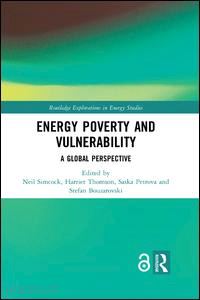Introduction Stefan Bouzarovski, Neil Simcock, Harriet Thomson, and Saska Petrova Energy poverty in an intersectional perspective: On multiple deprivation, discriminatory systems and the effects of policies Katrin Großmann and Antje Kahlheber Understanding energy poverty through the energy cultures framework Fatima McKague, Rob Lawson, Michelle Scott, and Ben Wooliscroft Transcending the triad: Political distrust, local cultural norms and reconceptualising the drivers of domestic energy poverty in the UK Irena L.C. Connon Post-apartheid spatial inequalities and the built environment: drivers of energy vulnerability for the urban poor in South Africa Abigail J. Knox, Jiska R. De Groot, and Nthabi Mohlakoana Water-energy nexus vulnerabilities in China: Infrastructures, policies, practices Alison Browne, Saska Petrova, and Beth Brockett Rethinking energy deprivation in Athens: a spatial approach Evangelia Chatzikonstantinou and Fereniki Vatavali Location, location, location: What accounts for the regional variation of energy poverty in Poland? Maciej Lis, Agata Miazga, and Katarzyna Salach Multiple vulnerabilities? Interrogating the spatial distribution of energy poverty measures in England Caitlin Robinson, Stefan Bouzarovski, and Sarah Lindley The triple-hit effect of disability and energy poverty: a qualitative case study of painful sickle cell disease and cold homes Anna Cronin de Chavez The value of experience: including young people in energy poverty research Kimberley C. O’Sullivan, Helen Viggers, and Philippa Howden-Chapman Energy poverty in the Western Balkans: adjusting policy responses to socio-economic drivers Slavica Robic, Ivana Rogulj, and Branko Ancic Lighting up rural Kenya: Lessons learnt from rural electrification programmes Dorice Agol Urban Energy Poverty: South Africa’s policy response to the challenge Peta Wolpe and Yachika Reddy ConclusionsNeil Simcock, Harriet Thomson, Saska Petrova, and Stefan Bouzarovski












